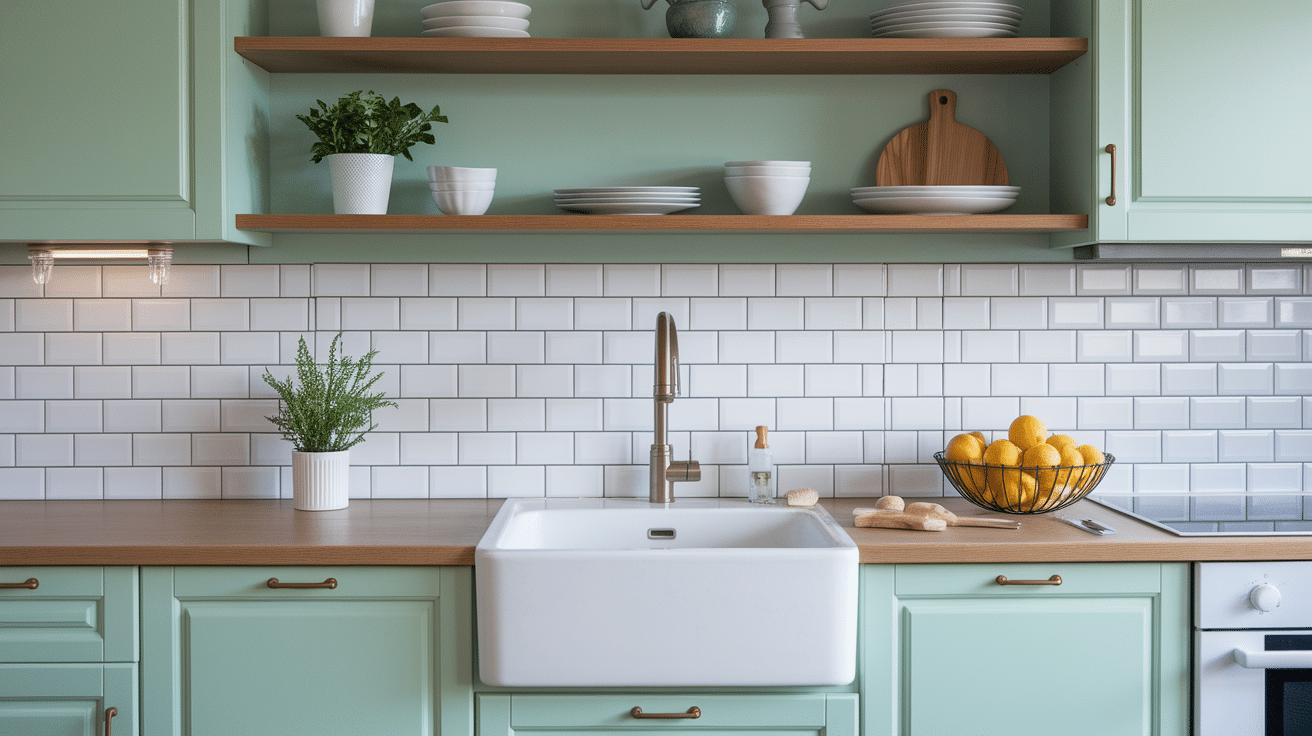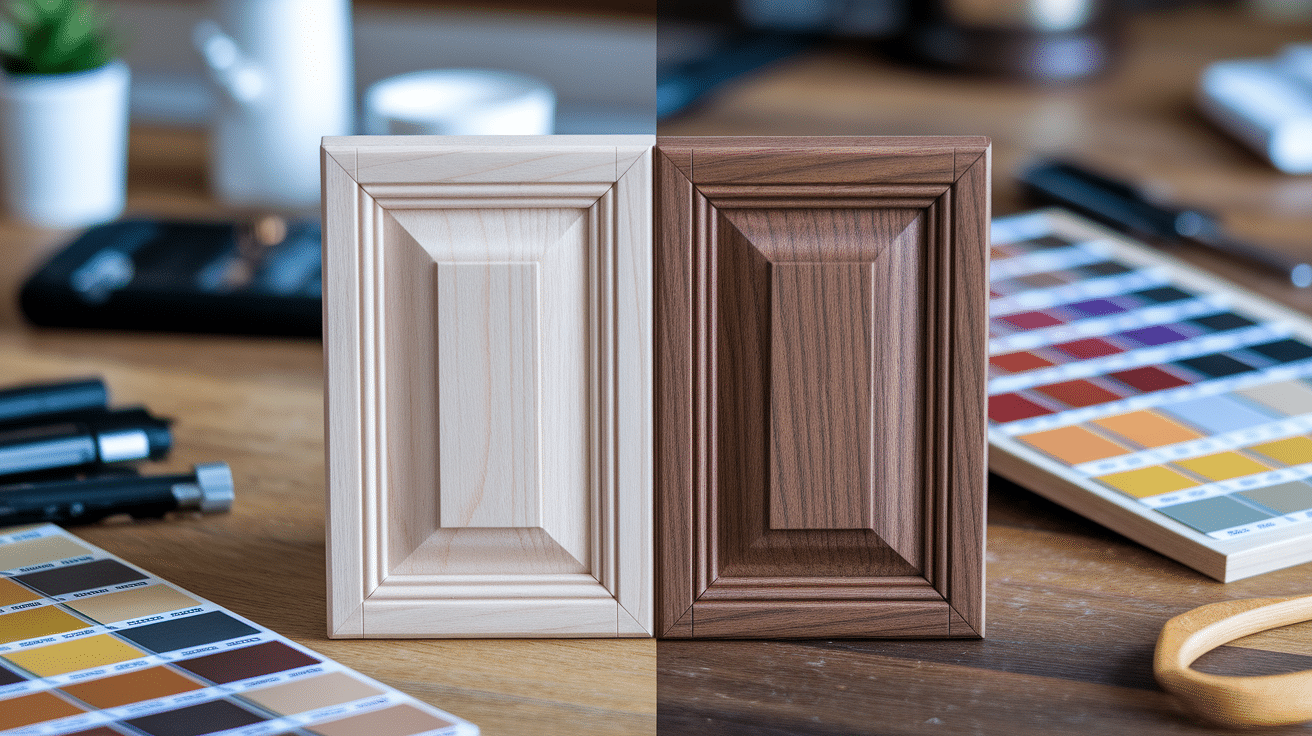Do your kitchen cabinets need a refresh? I understand how annoying cabinet refacing problems can be. Peeling veneer, uneven doors, and visible seams can turn your kitchen update into a headache.
I’ve helped many homeowners fix their cabinet refacing issues with simple solutions. These fixes don’t require expensive tools or expert skills.
Cabinet refacing saves money compared to full replacements while giving your kitchen a fresh look. But when problems pop up, you need quick fixes that work.
In this guide, I’ll show you 11 effective solutions to common cabinet refacing problems. You’ll learn how to handle issues from uneven surfaces to color-matching challenges.
Ready to fix those cabinet issues once and for all? Let’s get started with these practical solutions.
Why You Should Consider Redoing Your Cabinets?
Fixing up your old cabinets makes more sense than buying new ones. Cabinet refacing costs 30-50% less than full replacements. This option lets you keep your existing cabinet boxes while updating the faces.
Refacing gives your kitchen a fresh look without the mess. The process takes 2-5 days compared to weeks for full replacements. You can still use your kitchen during most of the work.
With updated doors and hardware, your cabinets will look new again. Modern styles and finishes can match current trends, making your whole kitchen feel updated.
Cabinet refacing extends the life of your cabinets by 10-15 years. The new surfaces protect the structure underneath, and quality materials resist wear better than old, tired surfaces.
Fixing small problems early prevents bigger issues later. Loose hinges can damage doors if not fixed. Water damage gets worse over time if not addressed. Early fixes save money in the long run.
This method is also better for the environment. Less material goes to landfills. Reusing cabinet boxes means fewer trees cut down. It’s a more responsible choice for home updates.
11 Kitchen Cabinet Refacing Problems and Solutions
1. Peeling Veneer or Laminate
Problem: Veneer or laminate starts peeling off due to heat, moisture, or poor adhesion.
Heat from cooking and water splashes can loosen cabinet veneers over time. You might notice edges lifting or bubbles forming under the surface. This happens when the glue breaks down between layers.
Solution: Fix small peeling spots with contact cement or wood glue. Clean both surfaces first. Apply glue to both sides and press firmly. Place heavy books on the area for 24 hours while it dries.
For large damaged areas, remove the old veneer completely. Clean the base cabinet well. Measure and cut new veneer sheets. Apply new adhesive evenly and press the new veneer into place with a roller.
2. Bubbling or Warping Surface
Problem: Bubbling occurs when air gets trapped under the veneer or laminate.
Air pockets form when adhesive isn’t applied evenly. Water seeping behind edges can also cause bubbles to form. These bubbles make your cabinets look bumpy and worn.
Solution: For small bubbles, use a syringe to inject adhesive under the bubble. Then press the area flat with a cloth. Hold something heavy on top until dry.
For larger bubbles, cut a small slit in the bubble with a razor. Squeeze glue inside. Press the area flat with a roller. Wipe away excess glue quickly. Let it dry for 24 hours with weight on top.
3. Difficulty Matching New Veneer with Existing Cabinets
Problem: Mismatched colors and grains make the refacing look uneven.
Cabinet colors fade over time from sunlight and cleaning. New materials often look different from older ones. This creates a patchy look in your kitchen.
Solution: Buy extra veneer when refacing. Test stains on scrap pieces first. Apply stain in thin layers until the color matches. Let each layer dry before adding more.
Consider tinting your finish for better matching. Mix stain with clear finish for a custom color. Apply this to all surfaces for a unified look. This works better than trying to match factory colors.
4. Hinges and Hardware Misalignment
Problem: New hinges or hardware do not align with pre-existing holes.
Old hinge holes might not match the new hardware spacing. This creates problems when hanging doors. Doors may not close properly when holes don’t line up.
Solution: Fill old holes with wood filler or dowel plugs. Sand the area smooth when dry. Measure and mark new hole positions carefully. Drill pilot holes to prevent wood splitting.
Use adjustable hinges when possible. These allow for small position changes after installation. Some modern hinges have slots instead of holes for easier alignment.
5. Uneven Cabinet Doors After Refacing
Problem: Doors appear misaligned after installing the new surface.
Adding new materials changes door thickness. This affects how doors hang. Uneven doors create gaps and make your kitchen look sloppy.
Solution: Adjust hinges with a screwdriver for small fixes. Most modern hinges have adjustment screws. Turn these slightly to move doors up, down, left, or right.
For bigger issues, add thin shims behind hinges. Cut small pieces of cardboard or plastic. Place these behind the hinge to change the angle. Test the door after each adjustment.
6. Chipping and Scratching of New Surface
Problem: The newly refaced cabinets are prone to scratches.
Fresh veneer and laminate can chip at edges and corners. Daily use leaves marks on new surfaces. This damage makes your new cabinets look old fast.
Solution: Apply clear protective finish to all surfaces. Use polyurethane or acrylic sealer for wood veneers. These create a hard shield against damage.
Install bumper pads where doors meet frames. Use felt pads inside cabinets where items might scratch surfaces. Clean with soft cloths only, never abrasive cleaners or scrubbers.
7. Difficulty Removing Old Veneer or Laminate
Problem: Old surfaces are difficult to remove without damaging the cabinet base.
Old adhesives become very hard over time. Removing veneer often damages the wood underneath. This creates more work before new material can be applied.
Solution: Warm old veneer with a hair dryer or heat gun on low setting. This softens the glue underneath. Slide a putty knife under the edge while still warm. Work slowly to prevent gouging the wood.
For tough spots, apply citrus-based adhesive remover. Let it sit for the time on the label. Then gently lift the old veneer. Sand any rough spots after removal before adding new material.
8. Adhesive Residue Left Behind
Problem: Sticky residue remains after removing old veneer.
Old glue leaves a gummy layer that prevents new adhesives from working. This causes new veneer to fail if not addressed. Residue also shows through thin new materials.
Solution: Remove residue with adhesive solvent from hardware stores. Apply with a cloth and let sit for 5 minutes. Scrape gently with a plastic putty knife, not metal.
For stubborn spots, try heat and baking soda. Warm the area with a hair dryer. Sprinkle baking soda on the sticky spots. Rub with a damp cloth in circles. Rinse and let dry completely.
9. Poor Bonding of New Veneer
Problem: The new veneer doesn’t stick properly.
Dust, oil, or moisture prevents good adhesion. Room temperature also affects how well glue works. Poor bonding leads to early failure of your refacing project.
Solution: Clean surfaces thoroughly with denatured alcohol. This removes oils and dust. Let dry completely before applying adhesive. Work in a room between 65-75°F for best results.
Apply pressure evenly when installing new veneer. Use a J-roller tool to press from center outward. Cover large areas with plywood sheets and add weights on top. Leave weights for 24 hours minimum.
10. Gaps Between Refaced Panels
Problem: Gaps or seams appear between the panels.
Small gaps form at seams where veneer pieces meet. These collect dirt and make your work look unprofessional. Water can seep into gaps and cause damage.
Solution: Fill small gaps with color-matched wood filler. Apply with a small putty knife. Wipe away excess before it dries. Sand lightly when completely dry.
For visible seams, use wax fill sticks in matching colors. These work like crayons to fill gaps. They don’t shrink or crack over time. Buff with a soft cloth after application for a smooth finish.
11. Issues with Paint or Finish Adhering
Problem: Paint or finish doesn’t stick to the new surface.
Smooth laminates and veneers resist paint naturally. Factory finishes often have wax or oil that blocks new coatings. This causes peeling and bubbling of new paint.
Solution: Sand all surfaces lightly with 220-grit sandpaper. This creates tiny scratches for paint to grip. Wipe away all dust with a tack cloth before painting.
Apply a bonding primer made for glossy surfaces. These stick to almost anything. Let primer dry completely before adding paint. Use two thin coats of paint rather than one thick layer for better results.
Common Mistakes to Avoid When Refacing Cabinets
Rushing Through Surface Preparation
Many people skip proper prep work to save time. This is a big mistake. Dirty or uneven surfaces cause new veneers to fail quickly.
I always clean cabinets with mild soap and water first. Then I use sandpaper to create a rough surface. This helps the new materials stick better. Let surfaces dry fully before adding new material.
Taking an extra hour for prep saves days of fixes later. Remove all handles, knobs, and hinges before starting. Fill any holes or dents with wood filler. Sand everything smooth before applying new veneer.
Choosing Low-Quality Adhesives or Veneers
Cheap materials lead to early failures. Low-cost veneers often peel within months. Poor adhesives don’t hold up to kitchen heat and moisture.
I recommend buying the best materials you can afford. Look for cabinet-grade veneers with real wood. These last much longer than paper-thin options.
Use adhesives made for kitchen use. These resist heat and water damage. Contact cement works well for most refacing projects. Read reviews before buying any products.
Ignoring the Importance of Precise Measurements
Small measurement errors cause big problems. Doors that don’t close right or gaps between pieces look bad. Fixing these issues takes more time than measuring right the first time.
I always measure twice and cut once. Use a tape measure and mark all cuts clearly. Add 1/8 inch extra when cutting veneer sheets. You can trim excess later, but you can’t add material back.
Make paper templates for odd-shaped areas. This prevents wasting expensive veneer. Label all pieces as you remove them to remember where they go.
Forgetting to Test Paint or Stain on a Sample Piece
Colors often look different once applied. What looks good on a sample card might look wrong on your cabinets. Testing prevents whole-kitchen color mistakes.
I always test finishes on scrap pieces first. Apply the stain or paint exactly as you plan to on the cabinets. Let it dry fully to see the true color. Look at it in both daytime and evening light.
Buy small samples of stain or paint before getting full cans. Mix custom colors on test pieces until you find the perfect match. Keep notes on your formula for future touch-ups.
Skipping Sealing and Protection After Refacing
Many people finish refacing but forget to seal the work. Without protection, your new surfaces won’t last. Water, heat, and cleaning products damage unsealed veneers quickly.
I apply at least two coats of clear finish to all surfaces. This creates a shield against kitchen hazards. Choose water-based polyurethane for easy cleanup and low odor.
Wait full drying time between coats. Don’t rush this final step. Add small bumpers inside doors to prevent banging. These steps extend the life of your refacing job by years.
Conclusion
Cabinet refacing gives your kitchen new life without the cost of full replacement. The common problems we covered—from peeling veneer to uneven doors—all have simple fixes.
Remember to take your time with preparation. Use good materials. Measure twice. Test colors before applying. Seal your work when done.
These steps help you avoid the top mistakes most DIYers make. Your cabinets will look better and last longer with proper care.
What’s next? Start by checking your cabinets for any signs of these issues. Fix small problems now before they grow larger. Take photos before you begin for reference.
Have you faced any other cabinet refacing challenges? Share your experiences in the comments below. I’d love to hear about your kitchen projects!



















